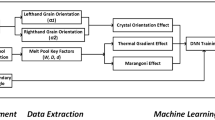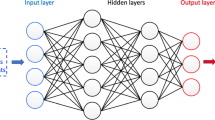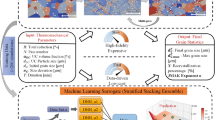Abstract
Predicting the temperature field during the direct energy deposition (DED) process is vital for the microstructure control and property tuning of fabricated metals. The widely used data-driven machine learning method for accurate temperature prediction, however, is impractical and computation-intensive due to its sole reliance on large datasets; also being a black-box model in nature, it lacks interpretability. We propose a physics informed neural network (PINN) model, which adopts a novel physics-data hybrid method by embedding the heat transfer law into the loss function of the neural network, to model the temperature field in both single-layer and multi-layer DED. The results show that the PINN-based models with additional extrapolation ability can accurately predict temperatures with a mean relative error of 4.83%, and achieve identical prediction accuracy with only 20% of the labeled data required for training the data-driven deep neural network. The proposed model is more explainable in terms of the physics of the DED process and is also applicable for the DED of different metals.


















Similar content being viewed by others
Availability of data and material
The data that support the findings of this study are available from the corresponding author upon reasonable request.
Code availability
All the codes of this study are available from the corresponding author upon reasonable request.
References
Shamsaei N, Yadollahi A, Bian L, Thompson SM (2015) An overview of direct laser deposition for additive manufacturing; part ii: mechanical behavior, process parameter optimization and control. Addit Manuf 8:12–35. https://doi.org/10.1016/j.addma.2015.07.002
Thompson SM, Bian L, Shamsaei N, Yadollahi A (2015) An overview of direct laser deposition for additive manufacturing; part i: transport phenomena, modeling and diagnostics. Addit Manuf 8:36–62. https://doi.org/10.1016/j.addma.2015.07.001
Liu W, Tang Z, Liu X, Wang H, Zhang H (2017) A review on in-situ monitoring and adaptive control technology for laser cladding remanufacturing. Procedia CIRP 61:235–240. https://doi.org/10.1016/j.procir.2016.11.217
Bontha S, Klingbeil NW, Kobryn PA, Fraser HL (2006) Thermal process maps for predicting solidification microstructure in laser fabrication of thin-wall structures. J Mater Process Technol 178(1):135–142. https://doi.org/10.1016/j.jmatprotec.2006.03.155
Kundakcioglu E, Lazoglu I, Rawal S (2016) Transient thermal modeling of laser-based additive manufacturing for 3D freeform structures. Int J Adv Manuf Technol 85(1):493–501. https://doi.org/10.1007/s00170-015-7932-2
Foroozmehr E, Kovacevic R (2010) Effect of path planning on the laser powder deposition process: thermal and structural evaluation. Int J Adv Manuf Technol 51(5):659–669. https://doi.org/10.1007/s00170-010-2659-6
Yan H, Shen L, Wang X, Tian Z, Xu G, Xie D, Liang H (2018) Stress and deformation evaluation of the subarea scanning effect in direct laser-deposited Ti-6Al-4V. Int J Adv Manuf Technol 97(1):915–926. https://doi.org/10.1007/s00170-018-1983-0
Yang Q, Zhang P, Cheng L, Min Z, Chyu M, To AC (2016) Finite element modeling and validation of thermomechanical behavior of Ti-6Al-4V in directed energy deposition additive manufacturing. Addit Manuf 12:169–177. https://doi.org/10.1016/j.addma.2016.06.012
Rangaswamy P, Griffith ML, Prime MB, Holden TM, Rogge RB, Edwards JM, Sebring RJ (2005) Residual stresses in LENS® components using neutron diffraction and contour method. Mater Sci Eng A 399(1):72–83. https://doi.org/10.1016/j.msea.2005.02.019
Zhang L, Chen X, Zhou W, Cheng T, Chen L, Guo Z, Han B, Lu L (2020) Digital twins for additive manufacturing: a state-of-the-art review. Appl Sci 10(23):8350. https://doi.org/10.3390/app10238350
Kong F, Kovacevic R (2010) Modeling of heat transfer and fluid flow in the laser multilayered cladding process. Metall and Mater Trans B 41(6):1310–1320. https://doi.org/10.1007/s11663-010-9412-2
Lindgren L-E, Hedblom E (2001) Modelling of addition of filler material in large deformation analysis of multipass welding. Commun Numer Methods Eng 17(9):647–657. https://doi.org/10.1002/cnm.414
Zheng J, Ince A, Tang L (2018) Modeling and simulation of weld residual stresses and ultrasonic impact treatment of welded joints. Procedia Engineering 213:36–47. https://doi.org/10.1016/j.proeng.2018.02.005
Michaleris P (2014) Modeling metal deposition in heat transfer analyses of additive manufacturing processes. Finite Elem Anal Des 86:51–60. https://doi.org/10.1016/j.finel.2014.04.003
Heigel JC, Michaleris P, Reutzel EW (2015) Thermo-mechanical model development and validation of directed energy deposition additive manufacturing of Ti–6Al–4V. Addit Manuf 5:9–19. https://doi.org/10.1016/j.addma.2014.10.003
Irwin J, Reutzel EW, Michaleris P, Keist J, Nassar AR (2016) Predicting microstructure from thermal history during additive manufacturing for Ti-6Al-4V. J Manuf Sci Eng 138(11):111007. https://doi.org/10.1115/1.4033525
Bai X, Zhang H, Wang G (2013) Improving prediction accuracy of thermal analysis for weld-based additive manufacturing by calibrating input parameters using IR imaging. Int J Adv Manuf Technol 69(5):1087–1095. https://doi.org/10.1007/s00170-013-5102-y
Ren X, Chai Z, Xu J, Zhang X, He Y, Chen H, Chen X (2020) A new method to achieve dynamic heat input monitoring in robotic belt grinding of Inconel 718. J Manuf Process 57:575–588. https://doi.org/10.1016/j.jmapro.2020.07.018
Zhou Z, Shen H, Liu B, Du W, Jin J (2021) Thermal field prediction for welding paths in multi-layer gas metal arc welding-based additive manufacturing: a machine learning approach. J Manuf Process 64:960–971. https://doi.org/10.1016/j.jmapro.2021.02.033
Stathatos E, Vosniakos G-C (2019) Real-time simulation for long paths in laser-based additive manufacturing: a machine learning approach. Int J Adv Manuf Technol 104(5):1967–1984. https://doi.org/10.1007/s00170-019-04004-6
Zhang Z, Liu Z, Wu D (2021) Prediction of melt pool temperature in directed energy deposition using machine learning. Addit Manuf 37:101692. https://doi.org/10.1016/j.addma.2020.101692
Mozaffar M, Paul A, Al-Bahrani R, Wolff S, Choudhary A, Agrawal A, Ehmann K, Cao J (2018) Data-driven prediction of the high-dimensional thermal history in directed energy deposition processes via recurrent neural networks. Manufacturing Letters 18:35–39. https://doi.org/10.1016/j.mfglet.2018.10.002
Ren K, Chew Y, Zhang YF, Fuh JYH, Bi GJ (2020) Thermal field prediction for laser scanning paths in laser aided additive manufacturing by physics-based machine learning. Comput Methods Appl Mech Eng 362:112734. https://doi.org/10.1016/j.cma.2019.112734
Zhang R, Liu Y, Sun H (2020) Physics-informed multi-LSTM networks for metamodeling of nonlinear structures. Comput Methods Appl Mech Eng 369:113226. https://doi.org/10.1016/j.cma.2020.113226
Zhu Q, Liu Z, Yan J (2021) Machine learning for metal additive manufacturing: predicting temperature and melt pool fluid dynamics using physics-informed neural networks. Comput Mech 67(2):619–635. https://doi.org/10.1007/s00466-020-01952-9
Raissi M, Perdikaris P, Karniadakis GE (2019) Physics-informed neural networks: a deep learning framework for solving forward and inverse problems involving nonlinear partial differential equations. J Comput Phys 378:686–707. https://doi.org/10.1016/j.jcp.2018.10.045
Shukla K, Di Leoni PC, Blackshire J, Sparkman D, Karniadakis GE (2020) Physics-informed neural network for ultrasound nondestructive quantification of surface breaking cracks. J Nondestr Eval 39(3):61. https://doi.org/10.1007/s10921-020-00705-1
He Q, Barajas-Solano D, Tartakovsky G, Tartakovsky AM (2020) Physics-informed neural networks for multiphysics data assimilation with application to subsurface transport. Adv Water Resour 141:103610. https://doi.org/10.1016/j.advwatres.2020.103610
Tartakovsky AM, Marrero CO, Perdikaris P, Tartakovsky GD, Barajas-Solano D (2020) Physics-informed deep neural networks for learning parameters and constitutive relationships in subsurface flow problems. Water Resour Res 56(5). https://doi.org/10.1029/2019WR026731
Noakoasteen O, Wang S, Peng Z, Christodoulou C (2020) Physics-informed deep neural networks for transient electromagnetic analysis. IEEE Open Journal of Antennas and Propagation 1:404–412. https://doi.org/10.1109/OJAP.2020.3013830
Kissas G, Yang Y, Hwuang E, Witschey WR, Detre JA, Perdikaris P (2020) Machine learning in cardiovascular flows modeling: predicting arterial blood pressure from non-invasive 4D flow MRI data using physics-informed neural networks. Comput Methods Appl Mech Eng 358:112623. https://doi.org/10.1016/j.cma.2019.112623
Fang Z, Zhan J (2020) Deep physical informed neural networks for metamaterial design. IEEE Access 8:24506–24513. https://doi.org/10.1109/ACCESS.2019.2963375
Mao Z, Jagtap AD, Karniadakis GE (2020) Physics-informed neural networks for high-speed flows. Comput Methods Appl Mech Eng 360:112789. https://doi.org/10.1016/j.cma.2019.112789
Baydin AG, Pearlmutter BA, Radul AA, Siskind JM (2018) Automatic differentiation in machine learning: a survey. Computer Science 18:43
Nwankpa C, Ijomah W, Gachagan A, Marshall S (2018) Activation functions: comparison of trends in practice and research for deep learning. arXiv preprint arXiv:1811.03378
Kingma D, Science JBJC (2014) Adam: a method for stochastic optimization
Byrd RH, Lu P, Nocedal J, Zhu C (1995) A limited memory algorithm for bound constrained optimization. SIAM J Sci Comput 16(5):1190–1208. https://doi.org/10.1137/0916069
Fossum ER, Hondongwa DB (2014) A review of the pinned photodiode for CCD and CMOS image sensors. IEEE Journal of the Electron Devices Society 2(3):33–43. https://doi.org/10.1109/JEDS.2014.2306412
Denlinger ER, Jagdale V, Srinivasan GV, El-Wardany T, Michaleris P (2016) Thermal modeling of Inconel 718 processed with powder bed fusion and experimental validation using in situ measurements. Addit Manuf 11:7–15. https://doi.org/10.1016/j.addma.2016.03.003
Ahn DG, Byun KW, Kang MC (2010) Thermal characteristics in the cutting of Inconel 718 superalloy using CW Nd: YAG laser. J Mater Sci Technol 26(4):362–366. https://doi.org/10.1016/S1005-0302(10)60059-X
Alimardani M, Toyserkani E, Huissoon JP (2008) Effect of preheating on the delamination and crack formation in laser solid freeform fabrication process. ASME 2008 International Mechanical Engineering Congress and Exposition 29–37. https://doi.org/10.1115/IMECE2008-67991
Buchbinder D, Meiners W, Pirch N, Wissenbach K, Schrage JJJoLA, (2014) Investigation on reducing distortion by preheating during manufacture of aluminum components using selective laser melting. J Laser Appl 26(1):012004. https://doi.org/10.2351/1.4828755
Kim H, Lee KK, Ahn DG, Lee HJM (2021) Effects of deposition strategy and preheating temperature on thermo-mechanical characteristics of Inconel 718 super-alloy deposited on AISI 1045 substrate using a DED process. Materials 14(7):1794. https://doi.org/10.3390/ma14071794
Ren K, Chew Y, Fuh JYH, Zhang YF, Bi GJ (2019) Thermo-mechanical analyses for optimized path planning in laser aided additive manufacturing processes. Mater Des 162:80–93. https://doi.org/10.1016/j.matdes.2018.11.014
Chen T, Guestrin C (2016) XGBoost: a scalable tree boosting system. Proceedings of the 22nd ACM SIGKDD International Conference on Knowledge Discovery and Data Mining 785–794. https://doi.org/10.1145/2939672.2939785
Rao C, Sun H, Liu Y (2020) Physics-informed deep learning for incompressible laminar flows. Theor Appl Mech Lett 10(3):207–212. https://doi.org/10.1016/j.taml.2020.01.039
Funding
This work was supported by the National Key R&D Program of China [2018YFC0310400], and Guangzhou Risong Intelligent Technology Holding Co., Ltd. China, [Grant numbers: 2020-L021].
Author information
Authors and Affiliations
Contributions
Jibing Xie: investigation, methodology, coding, analyzing, writing—original draft. Ze Chai: writing—review and editing. Xukai Ren: writing—review and editing. Luming Xu: experimentation. Sheng Liu: data analysis. Xiaoqi Chen: conceptualization, funding acquisition, writing—review, and revision.
Corresponding author
Ethics declarations
Ethical approval
Not applicable.
Consent to participate
The manuscript has been read and approved by all authors.
Consent for publication
Not applicable.
Competing interests
The authors declare no competing interests.
Additional information
Publisher's Note
Springer Nature remains neutral with regard to jurisdictional claims in published maps and institutional affiliations.
Rights and permissions
About this article
Cite this article
Xie, J., Chai, Z., Xu, L. et al. 3D temperature field prediction in direct energy deposition of metals using physics informed neural network. Int J Adv Manuf Technol 119, 3449–3468 (2022). https://doi.org/10.1007/s00170-021-08542-w
Received:
Accepted:
Published:
Issue Date:
DOI: https://doi.org/10.1007/s00170-021-08542-w




